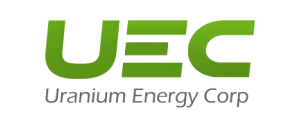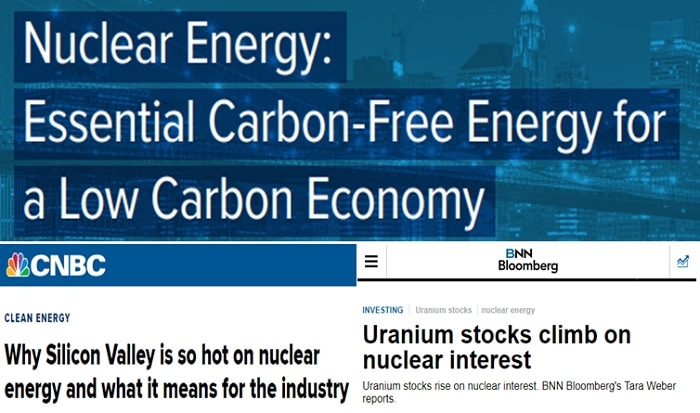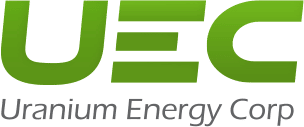IN THIS REPORT
Russia and China are Dominating
Nuclear Energy…
But AMERICA just kicked off a
Major Nuclear Energy Race
- 437 nuclear power plants operating in 33 countries combine to provide ~10% of the world’s electricity needs.
- 60 new reactors are under construction worldwide.
- Globally, 99 nuclear reactors are planned, with over 300 more in the proposal stage.
After the Fukushima nuclear reactor accident in 2011, support for nuclear power hit a new low (despite zero nuclear related fatalities).
The price of uranium also fell… into a prolonged bear market.
But fast-forward to 2021, uranium prices finally recovered to pre-Fukushima levels.
- There’s renewed interest in nuclear energy.
Today, nuclear energy has a critical role to play as the world to get to net zero carbon emissions…it is safe, highly reliable and a clean energy.
The last time anything like this happened in the uranium market was more than a decade ago.
The price of uranium skyrocketed from $12 per pound to $137 per pound – a 1,041% rise – in just three years.
Many uranium stocks climbed more than 3,000%…
The world’s largest publicly traded uranium miner, Cameco, increased in value 20-fold…
And some of the smaller, more speculative uranium stocks shot up more than 100x.
As a pureplay uranium producer, Uranium Energy Corp (NYSE: UEC) is well-positioned to capitalize on America’s nuclear energy renaissance.
You might already be thinking to yourself, “What are the chances of uranium going up from here?”
Well, as it turns out, things are looking quite promising for uranium.
Uranium’s Price Trajectory Looks Incredible
Long story short, nuclear energy will have a major role to play in the global energy mix as the world continues moving towards net zero emissions.
[NOTE: If you haven’t had the chance to view the entirety of our Nuclear Education Series, Click the link to get up to speed on the coming uranium bull market and how the uranium markets, will play a major role in the carbon revolution.]
As you can see, not only does nuclear beat all the traditional forms of baseload power, such as natural gas…
When emissions through the entire lifecycle (materials acquisition, construction, transport etc.) are taken into account…
It’s cleaner than just about all forms of renewable energy, like solar and hydro.
The fact is, nuclear still represents one of the best options that many countries are turning to as part of their transition away from traditional fossil fuel and intermittent solar and wind power.
FACT:
- Last year, 437 nuclear power plants operating in 33 countries combined to provide ~10% of the world’s electricity needs.
Now, there are a further 60 reactors being build.
That represents a 14% jump over where we are now.
Globally, a total of 99 nuclear reactors are on order or planned, with over 300 more in the proposal stage.
And consider these recent Headlines:
We’re not just talking “maybes” here…. Nuclear is back.
The Big Shift Toward Nuclear Power & Increasing Uranium Demand is Already Happening
The World Nuclear Association expects uranium demand to increase by 27% from 2021 levels through 2030, and by another 41% from 2031-2040.
In 2022-2023, the gap between production and reactor demand exceeds 100 million pounds of uranium. For context, the U.S. nuclear fleet consumes about 47 million lbs/year.
Utilities are more than 50% uncovered in their supply by 2030 with the production and requirements gap averaging about 36 million pounds per year through this decade.
While this gap is being filled with secondary supply (e.g., inventories) the sources that have been available are rapidly diminishing.
If nothing is done to address the situation, the supply demand imbalance will require more uranium production and/or higher prices.
The next question is:
How does Uranium Energy Corp (UEC:NYSE) fit into that picture?
UEC is America’s leading, fastest growing, pure play uranium mining company and it’s listed on the NYSE American.
UEC is also the largest, diversified yet North American focused uranium company.
They are advancing the next generation of low-cost, environmentally friendly In-Situ Recovery (ISR) mining uranium projects in the United States and a pipeline of high-grade conventional projects in Canada.
It’s important to note that UEC’s production is unhedged, meaning that the company’s performance will be fully exposed to the price action of uranium.
When uranium prices rise, UEC can “turn on the taps” to produce uranium to sell in the open market.
So, UEC’s share price will be more heavily influenced by uranium’s spot price than other companies who have hedged their production.
In a nuclear bull market, that’s a very good thing.
Let’s dive into the company, starting with the most important component…
Meet The UEC Management Team
Amir Adnani – President, CEO, Director
One of the founders of UEC, Amir is a superstar in the resource investing world with a number of other successful companies like GoldMining Inc. and Uranium Royalty Corp. under his belt.
With years of directly relevant experience in public markets, he’s often invited to speak at major industry events hosted by organizations.
Under his leadership, UEC has become the largest U.S.-based Uranium company.
Amir will no doubt continue to have a significant role to play for UEC as America continues its path towards net zero.
Spencer Abraham – Chairman of the Board
A former U.S. Senator (1995-2001) and served as the U.S. Secretary of Energy from 2001-2005 under the first Bush administration.
Spencer’s passion for and focus on national energy security led him to UEC. Before that, he was:
- Chairman of the U.S. board for European uranium giant AREVA, as well as
- Director of Occidental Petroleum, one of Warren Buffett’s largest holdings
With both his unique energy industry and political experience, not to mention his connections, Spencer is an invaluable resource for UEC.
Scott Melbye – Executive Vice President
Scott is a four-decade veteran of the energy markets whose resume reads like a who’s who of the uranium industry.
- 22 years with Cameco where he was responsible for the sales and trading of all of Cameco’s uranium production.
- VP Commercial for what is now known as the Sprott Physical Uranium Trust
- Advisor to the CEO for the world’s largest uranium producer Kazatomprom,
- Executive VP of Marketing for Uranium One.
Scott’s wealth of hands-on experience when it comes to uranium marketing and sales complements Amir and Spencer’s talents perfectly. His knowhow ensures that UEC can secure the best prices and agreements for its uranium production.
UEC’s management team is lined with heavy hitters who are all on top of not just the uranium sector, but their respective niches within it.
These industry veterans have already guided UEC into becoming the top domestic U.S. uranium company during a time uranium was down in the dumps, and they’re now perfectly positioned to capitalize on its massive resurgence.
How to Profit from America’s “Onshoring” of Uranium
Last year, U.S. nuclear power plants purchased around 47 million pounds of uranium to run their reactors.
However, domestic U.S. uranium production was virtually non-existent as U.S. utilities bought almost 60% of their uranium from Russia and its Kazakhstan and Uzbekistan allies state owned companies (SOEs).
This reliance has eroded the U.S. nuclear fuel cycle, threatening U.S. national security and strengthening the Putin regime.
Uranium powers 1 out of every 5 American homes, providing around half of the U.S.’s carbon-free power.
With Russia’s invasion of Ukraine, the overdependence on countries with high geopolitical risks has become a major security of supply issue for U.S. and other Western utilities looking for supply from politically safe and stable jurisdictions.
Not surprisingly, uranium supply from U.S. producers is receiving a high level of new interest from the utility industry.
The U.S. federal government is also taking steps to establish a foundation for the industry to recover, starting with the U.S. Nuclear Fuel Working Group (“NFWG”).
The NFWG issued a strategy report calling for increased U.S. leadership in nuclear energy, both at home and abroad, with a focus on U.S. national security objectives that included lessening dependence on SOE uranium supply from Russia and its allies.
Uranium mining is the starting point in the NFWG strategy with a program to purchase 17 to 19 million pounds of U.S. uranium for a strategic Uranium Reserve (the “UR”).
The report outlined a 10-year, $1.5 billion UR program.
In 2020, the U.S. Congress approved $75 million for initial funding for fiscal year 2021. In July of 2022, the DOE National Nuclear Security Administration(“NNSA”) issued Requests for Proposals (“RFP”) to the U.S. producers that had produced uranium since 2009, for an initial quantity of up to 1 million pounds of domestic uranium.
U.S. Uranium Production Has Been Decimated But is Poised for Recovery with UEC
To see exactly just how UEC is positioned as a diversified, yet still North American focused supplier, let’s review their resources.
Uranium Energy Corp (UEC:NYSE) is sitting on significant quantities of uranium located in the Americas.
That includes 198 million pounds of the higher quality “Measured and Indicated” (M&I) category.
And another 68 million pounds is in the “Inferred” category.
UEC supply solves the “Former Soviet Union SOE geopolitical supply chain” risk problem – because most of UEC’s projects are based in America and Canada.
Below is a graphic showing the location of UEC’s uranium resources:
The bulk of these resources are fully S-K 1300 compliant. This means that they conform to the stringent technical standards for reporting as required by the SEC and they mark the largest S-K 1300 uranium resources reported in the United States.
Not included in the 266 million pounds of uranium mentioned above is the Roughrider project, also located in Canada near the rest of UEC’s Canadian projects.
A very recent acquisition, the Roughrider project has a sizeable historic resource of 58 million pounds of uranium. This resource isn’t S-K 1300 compliant yet, but UEC’s current top priority is producing an updated S-K 1300 technical report for the project.
Key Growth Drivers
A very important resource for mining companies that is often overlooked is cash.
Whether it’s for new acquisitions, developing projects, or building a mine, cash is king in the mining industry, and uranium is no exception.
- Right now, UEC is sitting on a sizeable war chest of $93 million in cash and liquid assets, with no debt.
That’s an amazing balance sheet to have, and it’s all thanks to Amir and his team’s careful management of the company through tough times in the uranium markets.
Now that we have a better idea of where UEC sits in terms of its key assets, let’s take a closer look at how it uses those assets.
Operations
We’ll start by looking at UEC’s most “advanced” projects – their fully operational processing plants and permitted ISR (in-situ recovery) projects in the U.S.
Wyoming & Texas ISR
For many years following the Fukushima incident, uranium prices were down in the dumps, making uranium production an unprofitable venture in many locations.
But the management team at UEC knew that it was only a matter of time until uranium made its comeback.
So, they made a critical business decision: they stopped all production to preserve its valuable in ground assets.
Buy Low & Sell High
ISR (in-situ recovery) is a environmentally friendly mining technique that only works with certain types of geologies. When it’s possible to use ISR, however, production costs are much lower than with conventional recovery methods.
Instead of producing, UEC acquired new projects in a market when prices were low, explored and developed properties, conducted studies and completed additional permitting required for production.
They also bought substantial physical uranium inventory at a volume weighted average price of ~$37 per pound. This is well below not only current spot prices, but also most miners’ cost to produce.
The strategic holding of drummed uranium bolsters their balance sheet as uranium prices appreciate, will accelerate cash flows in advance of production ramp-up, and ultimately augments the advancement of their U.S. uranium mining platform.
The availability of inventory also increases the availability of UEC’s Texas and Wyoming production capacity to pursue U.S. Government opportunities requiring U.S. origin uranium, which is likely to command a premium due to the scarcity of domestic uranium production.
Because of these various actions, UEC is now production ready in the mining friendly jurisdictions of Wyoming and Texas with two hub and spoke ISR production platforms and has significant inventory to bolster near term marketing efforts.
The seven ISR projects serves as spokes to the two fully built and operational processing plants, Irigaray and Hobson, that serve as the hubs in each state.
These hubs are the plants that actually turn the resin recovered from their ISR projects into uranium oxide and they are licensed to produce 6.5 million pounds of uranium per year.
The fact these plants are already built, licensed and operational is a huge advantage compared to those plants on the horizon that will have to be constructed with longer timelines and with much more inflationary cost structures.
UEC’s Wyoming and Texas Hub and Spoke Platforms holds the largest resource base of fully permitted In-Situ Recovery (“ISR”) projects in the United States.
Combining just the South Texas and Wyoming Hub & Spoke ISR Platforms, UEC controls over 60 million pounds of Measured and Indicated resources and 10.9 million pounds of Inferred resources.
- UEC is well positioned to restart and expand past U.S. uranium production at their Wyoming and Texas Hub and Spoke production platforms.
Beyond their seven primary ISR projects and their two processing plants, there are also a number of development- and resource-stage projects in Wyoming and Texas that represent a further 14.6 million pounds of Measured and Indicated, and 14.1 million pounds of Inferred uranium, with plenty of exploration potential across all properties.
North American Conventional
Aside from the ISR assets in Wyoming and Texas, UEC also owns sizeable conventional mining projects in two other locations in North America.
The first is located in Arizona, and consists of two projects: Anderson near Phoenix, and Workman Creek in central AZ.
Anderson has a sizeable indicated resource of 32 million pounds of uranium, while Workman Creek has a more modest inferred resource of 5.5 million pounds.
While both projects have seen feasibility studies done by previous owners, they would need more up-to-date development work to become mine site ready.
Across the border in Canada, UEC’s other conventional mining projects are located in the prolific Athabasca Basin, home of the uranium bull market rush back in 2007.
Infrastructure in the area is excellent thanks to the long history of uranium mining in the region, making the Athabasca Basin UEC’s third major production “hub”, behind Wyoming and Texas.
- Uranium Energy Corp’s (UEC:NYSE) four projects here combine for 82 million pounds of M&I uranium resources and 35 million pounds of Inferred resources.
- Also located here is the recent Roughrider acquisition, with its historic resource of 58 million pounds of uranium, giving UEC a large low cost Canadian portfolio.
While this is a substantial portion of UEC’s uranium resources, these projects are in the later development pipeline and would require more work done before being able to go into production.
However, Roughrider in particular has seen extensive work done by previous owners and has become a top development priority for UEC.
Paraguay
Finally, UEC has a couple growth tickets located in Paraguay, which hosts a small but foreign-investment-friendly mining industry.
- Of their two exploration-stage ISR projects in southern Paraguay, the first, Yuty, has an M&I resource of 8.9 million pounds and inferred resource of 2.2 million pounds of uranium.
- The other one, Oviedo, doesn’t have a resource yet, but the company has set an exploration target of 23-56 million pounds.
Rounding out their portfolio in Paraguay is the Alto Paraná Titanium project. It’s one of the largest and highest-grade Ferro-Titanium deposits in the world and is currently undergoing a preliminary economic assessment.
But while these Paraguayan projects are all very promising, they’re lower priorities for UEC and should be considered as icing on the proverbial cake. Where the cake in question is UEC’s North American assets.
Operations Summary
There’s a lot to unpack when it comes to UEC’s portfolio of assets, the company’s focus – its nearest-term catalysts – the fully permitted ISR projects along with their operational central processing plants in Wyoming and Texas.
These two ISR production platforms represent a production profile of 6.5 million pounds per year and production could start within a period of months once a restart decision is made.
The Palangana ISR mine in Texas, the one mine out of the seven mines that was previously producing, took just six months and $10 million to build out.
If Uranium Starts Trading Higher…
If uranium takes off again, surging north of $60, $70 as it has twice before in the past…
The value of UEC’s assets should show significant appreciation.
If uranium returns to its previous historical trading levels between $20-40/lb, then of course UEC’s value proposition decreases.
However, this seems unlikely for any prolonged period of time with production costs indicated north of $56/lb for most of the industry.
Given that UEC is an unhedged pureplay uranium producer, they should do quite well in a uranium bull market and unhedged, they have the ability to shut in production and control costs if the market were to have a significant drop.
Investors/Investments
As mentioned earlier, UEC is sitting on $93 million in cash and other liquid assets, with no debt.
This is an extremely strong financial position to be in, as it means the company won’t have to raise any money anytime soon – even the capital costs required to start producing uranium again are covered.
Their cash position is so healthy that UEC has been using it to go shopping.
For instance, UEC was able to use their cash to buy out the American operations of Uranium One, the world’s fourth largest uranium producer, at the end of last year. This is how UEC secured the bulk of their Wyoming assets.
More recently, just this past October, UEC bought the Roughrider project in the Athabasca Basin from Rio Tinto in a half-cash, half-stock deal valued at $150 million.
This was an amazing acquisition scored by UEC’s management team. They paid just $2.59 for each pound of uranium in the ground at Roughrider when the market was already giving the company a valuation of around $4.29 per pound.
That significant discount on their purchase price just goes to show how intelligently UEC’s management have been building out their uranium portfolio with accretive acquisitions in the past several years.
As far as UEC itself goes, management, insiders, and other strategic investors account for ~15% of the float. And the company can count a number of major funds among its strategic investors, such as Blackrock, Vanguard, Fidelity, and Sprott, to name but a few.
With names like those backing the company, you can rest assured that management is committed to delivering the best possible results for their shareholders.
Triggers
To cap it all off, there’s one more big reason why UEC’s assets are so attractively well-positioned.
~20% of the United States’ electricity production is derived from nuclear power:
While this proportion used to be higher (over 30%), one-fifth of total U.S. electricity production is still nothing to sneeze at.
And what about the uranium needed to power those reactors?
- Remember: last year the U.S. imported nearly 60% of its uranium from Russia and other Former Soviet Union countries.
Uranium Energy Corp is positioned to change that.
Perhaps most notably, just about half of U.S. uranium imports last year came from Russia and Kazakhstan combined.
Kazakhstan has very significant ties to Russia and is often considered to be Russia’s next closest ally after Belarus.
With the war in Ukraine, and Russia weaponizing its energy supply against Europe…
Energy security has become an even more important issue for the U.S. than ever before.
The U.S. has historically been a net importer of energy. They only became a net exporter recently, in 2019.
As the war in Ukraine drags on, continuing to back Russia into a corner, an increasingly desperate Putin might become more willing to use every tool at his disposal to save face at home…including shutting off nuclear fuel supply to the U.S.
In the meantime, the Russian military is benefitting from hundreds of millions of U.S. dollars in annual nuclear fuel purchases.
There are also proposed bills in the U.S. Congress to ban Russian nuclear fuel, so either Russian actions or U.S. actions could prompt an end to Russian nuclear fuel supply in the U.S., further increasing the importance of a secure domestic nuclear fuel supply chain and U.S. uranium production.
Which brings us back to why the details of UEC’s operations are so important.
When the COVID-19 pandemic hit, the supply chain disruptions that ensued taught many companies and governments a valuable lesson.
It led many to consider “reshoring” their logistics by moving foreign production back home.
Now, with the energy crisis in Europe directly resulting from the war in Ukraine and Putin’s aggressive policies on top…
A secure domestic supply of a vital energy source becomes more valuable than ever to the U.S. government, as well as U.S and other Western utilities.
That’s where UEC comes in.
With their U.S. near-term-production ready, low-cost ISR projects and processing facilities…
- UEC is poised to start producing uranium within a matter of months.
U.S. origin uranium is required for the U.S. Navy and other defense missions. When the American government starts looking for U.S. uranium, UEC should be one of the first places they look.
Even beyond American borders, demand for uranium around the world is expected to surge in the coming decades, leaving behind a supply shortfall that producers will be scrambling to fill. And U.S. and other Western utilities are looking for ways to reduce dependence on Russia and its allies for nuclear fuel supply.
In short, the next big uranium boom could be right around the corner, especially for uranium from safe and secure geopolitical jurisdictions like the United States and Canada, where UEC has the vast majority of its uranium resources.
Given that Canada and the U.S. are both extremely stable mining jurisdictions with easy access to foreign markets, we think UEC – as the leading American uranium mining company – is one of the best ways to capitalize on this huge new “clean energy reshoring” trend…
Disclosure
CarbonCredits.com publishes introductory corporate profiles based on its assessment of the interest that its readers will have in them. CarbonCredits.com is paid a fee by each corporation profiled. CarbonCredits.com principals may hold directly or indirectly stock in the company’s mentioned, and from time to time buy and sell securities in the profiled corporations but not during any marketing or promotional periods. Opinions expressed in this profile as they relate to the outlook for metals, potential for projects, expectations about possible future corporate spin-offs, and potential for share appreciation are the personal opinions of the principals of CarbonCredits.com.
Get Your Free Report on Uranium Energy Corp (UEC:NYSE)
America’s leading, fastest growing, uranium mining company listed on the NYSE.
- UEC is a pure-play uranium company advancing the next generation of low-cost, environmentally friendly In-Situ Recovery (ISR) uranium projects.


















